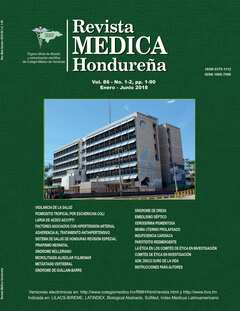Paraparesia secundaria a metástasis vertebral como manifestación inicial de un carcinoma de pulmón: reporte de caso y revisión bibliográfica
Palabras clave:
Compresión de la médula espinal, neoplasias pulmonares, paraparesiaResumen
Introducción: Las metástasis de la columna vertebral son la manifestación de una neoplasia sistémica. Se evidencia que la prevalencia de los tumores metastásicos de la columna es alta, siendo estos 40 veces más frecuentes que todos los tumores primarios óseos combinados. La historia natural de la columna vertebral metastásica es la compresión parcial o total de la médula espinal o de las raíces nerviosas conociéndose esto como síndrome de compresión medular. Un tercio de los casos que presentan este síndrome son la primera manifestación del tumor, especialmente en el cáncer de pulmón, con tendencia a metastatizar en un 13%. Caso Clínico: Se presenta el caso de un paciente masculino de 40 años de edad, sin antecedentes de interés, quien es ingresado por paraparesia asociada a incontinencia urinaria y fecal; dos días después del ingreso se le realizó una resonancia magnética con gadolinio la cual reportó lesión a nivel de T3 que comprimía y ensanchaba la vértebra por lo que se le diagnóstico síndrome de compresión medular. Se le realizó una laminectomia descompresiva y biopsia dando ésta el diagnóstico de carcinoma metastásico en columna vertebral, de probable origen pulmonar según estudio inmunohistoquímico. Conclusiones: El diagnóstico y tratamiento oportuno es fundamental para revertir la evolución natural de esta enfermedad, instaurándose el tratamiento dentro de las primeras 12 a 24 h evitando así una discapacidad neurológica signiicativa.
Descargas
269




